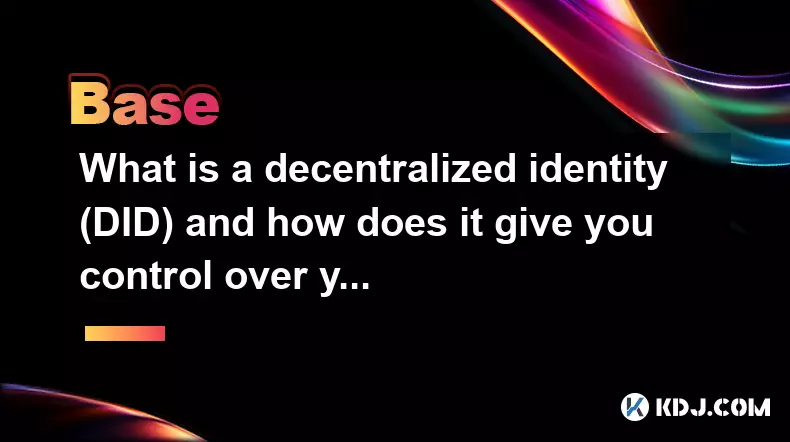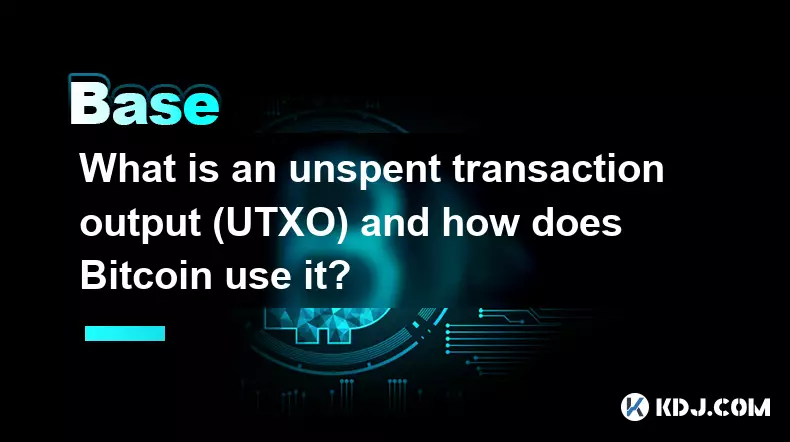-
 bitcoin
bitcoin $106680.127705 USD
0.67% -
 ethereum
ethereum $3615.722480 USD
-0.65% -
 tether
tether $0.999925 USD
-0.04% -
 xrp
xrp $2.550072 USD
5.91% -
 bnb
bnb $1002.572269 USD
-0.90% -
 solana
solana $168.746669 USD
1.08% -
 usd-coin
usd-coin $0.999832 USD
-0.03% -
 tron
tron $0.297244 USD
1.97% -
 dogecoin
dogecoin $0.182965 USD
0.71% -
 cardano
cardano $0.600432 USD
2.56% -
 hyperliquid
hyperliquid $41.439691 USD
-1.57% -
 chainlink
chainlink $16.548399 USD
2.40% -
 bitcoin-cash
bitcoin-cash $524.993680 USD
3.45% -
 stellar
stellar $0.302259 USD
4.10% -
 zcash
zcash $539.994871 USD
-16.31%
What is a decentralized identity (DID) and how does it give you control over your data?
Decentralized Identity (DID) empowers users with self-sovereign control, enabling secure, private, and portable digital identities via blockchain and cryptographic verification.
Nov 11, 2025 at 08:40 pm

Understanding Decentralized Identity (DID)
1. A decentralized identity (DID) is a type of digital identity that operates independently of centralized authorities such as governments or corporations. Unlike traditional identity systems where user data is stored on centralized servers, DIDs are built on blockchain and distributed ledger technologies. This architecture ensures that no single entity has control over the entire system.
2. Each DID is a unique identifier that can be verified through cryptographic methods. It allows individuals to prove ownership of their identity without relying on intermediaries. The identifier is typically linked to a public key, enabling secure authentication and data exchange.
3. DIDs are defined by open standards such as those developed by the World Wide Web Consortium (W3C). These standards ensure interoperability across platforms and networks, allowing users to maintain a consistent identity across multiple services and applications.
4. The structure of a DID includes a method-specific identifier and a document that contains metadata like public keys, authentication protocols, and service endpoints. This information is stored on a decentralized network, making it resistant to tampering and censorship.
5. Because DIDs are self-sovereign, users generate and manage them using digital wallets. These wallets act as personal identity hubs, giving individuals full authority over when and how their identity information is shared.
User Control Over Personal Data
1. With traditional online accounts, personal data is often collected, stored, and sometimes sold by service providers. In contrast, decentralized identity enables users to store their credentials locally, such as on a mobile device or hardware wallet. This shift places the individual at the center of data management.
2. When using a DID, individuals decide which pieces of information to disclose during interactions. For example, instead of providing an entire government ID, a user can share only the proof of age required for age verification. This concept is known as selective disclosure.
3. Users retain ownership of their data and can revoke access at any time. Once a service no longer needs access to certain credentials, the user can terminate that permission instantly. There is no need to trust third parties to delete or protect the data.
4. Authentication processes with DIDs do not require passwords. Instead, they rely on cryptographic signatures generated from private keys held exclusively by the user. This eliminates risks associated with password breaches and phishing attacks.
5. Data portability becomes seamless. Since identities are not tied to specific platforms, users can move between services without creating new accounts or repeating verification steps. Verified credentials issued once can be reused across different ecosystems.
Integration with Blockchain and Cryptocurrency Ecosystems
1. Decentralized identities are increasingly being adopted within cryptocurrency platforms to enhance security and compliance. Exchanges and DeFi protocols use DIDs to verify users while minimizing exposure of sensitive personal information.
2. In decentralized finance (DeFi), DIDs enable reputation-based lending models. Users can build creditworthiness over time by linking verified credentials to their wallet addresses, allowing for more personalized financial services without sacrificing privacy.
3. NFT marketplaces utilize DIDs to authenticate creators and prevent impersonation. Artists can link their identity to their digital works, ensuring provenance and protecting intellectual property rights.
4. DAOs (Decentralized Autonomous Organizations) implement DIDs for member verification and voting rights. This prevents sybil attacks and ensures that governance actions come from legitimate participants.
5. Smart contracts can interact with DIDs to automate identity-based logic. For instance, a contract might release funds only after verifying a user’s accreditation status via a trusted issuer’s signed credential.
Frequently Asked Questions
What happens if I lose access to my DID wallet?Losing access to your DID wallet means losing control of your identity, similar to losing a physical passport. Recovery depends on the wallet’s design—some offer backup mechanisms like seed phrases, while others may integrate social recovery methods where trusted contacts help restore access.
Can a DID be faked or duplicated?DIDs themselves cannot be duplicated due to their cryptographic foundation. Each DID is tied to a unique key pair. While someone could create a fake DID, it would not carry trusted verifiable credentials unless issued by recognized entities, making fraud detectable.
Who issues verifiable credentials for DIDs?Verifiable credentials are issued by trusted entities such as universities, employers, or government agencies. These issuers sign the credentials cryptographically, allowing recipients to present them as proof without revealing unnecessary details.
Are all DIDs stored on public blockchains?Not necessarily. While many DIDs are anchored on public blockchains for transparency and immutability, some systems use private or consortium-led distributed ledgers. The choice depends on the balance between privacy, scalability, and decentralization requirements.
Disclaimer:info@kdj.com
The information provided is not trading advice. kdj.com does not assume any responsibility for any investments made based on the information provided in this article. Cryptocurrencies are highly volatile and it is highly recommended that you invest with caution after thorough research!
If you believe that the content used on this website infringes your copyright, please contact us immediately (info@kdj.com) and we will delete it promptly.
- HUGS Presale: Milk Mocha's Crypto Revolution is Here!
- 2025-11-12 03:30:01
- Bitcoin, Presale Tokens, and Crypto Buys: Navigating the NYC Crypto Scene
- 2025-11-12 02:55:01
- HUGS Presale Crypto: Early Access to the Milk Mocha Revolution!
- 2025-11-12 02:50:01
- Cryptocurrencies, Long-Term & BlockDAG: Navigating the Future in 2025
- 2025-11-12 01:30:01
- Navigating Crypto Investment: The Rise of Super Platforms and Unified Ecosystems
- 2025-11-12 01:50:01
- Canton Network's Wild Ride: Price Dip, Exchange Listings, and What It All Means
- 2025-11-12 01:20:02
Related knowledge

What is the difference between a transparent and a shielded transaction?
Nov 10,2025 at 05:59pm
Understanding Transparent Transactions in Cryptocurrency1. Transparent transactions are the standard form of transaction on most public blockchains li...

What is a "crypto airdrop farmer" and what strategies do they use?
Nov 09,2025 at 03:39pm
What Is a Crypto Airdrop Farmer?1. A crypto airdrop farmer is an individual who actively participates in blockchain projects to qualify for free token...

What is an unspent transaction output (UTXO) and how does Bitcoin use it?
Nov 12,2025 at 01:40am
Understanding the Concept of Unspent Transaction Output (UTXO)1. An Unspent Transaction Output, commonly referred to as UTXO, is a fundamental compone...

How does a crypto insurance protocol work?
Nov 08,2025 at 12:39am
Understanding Crypto Insurance Protocols1. A crypto insurance protocol operates by offering financial protection against losses incurred from digital ...

What is token composability and why is it called "DeFi Legos"?
Nov 09,2025 at 06:39am
Bitcoin's Role in Decentralized Finance1. Bitcoin remains the cornerstone of decentralized finance, serving as a benchmark for value and trustlessness...

What is an "exploit" versus a "hack" in the context of smart contracts?
Nov 09,2025 at 12:40am
Understanding Exploits in Smart Contracts1. An exploit refers to the utilization of a known vulnerability within a smart contract’s code to gain unint...

What is the difference between a transparent and a shielded transaction?
Nov 10,2025 at 05:59pm
Understanding Transparent Transactions in Cryptocurrency1. Transparent transactions are the standard form of transaction on most public blockchains li...

What is a "crypto airdrop farmer" and what strategies do they use?
Nov 09,2025 at 03:39pm
What Is a Crypto Airdrop Farmer?1. A crypto airdrop farmer is an individual who actively participates in blockchain projects to qualify for free token...

What is an unspent transaction output (UTXO) and how does Bitcoin use it?
Nov 12,2025 at 01:40am
Understanding the Concept of Unspent Transaction Output (UTXO)1. An Unspent Transaction Output, commonly referred to as UTXO, is a fundamental compone...

How does a crypto insurance protocol work?
Nov 08,2025 at 12:39am
Understanding Crypto Insurance Protocols1. A crypto insurance protocol operates by offering financial protection against losses incurred from digital ...

What is token composability and why is it called "DeFi Legos"?
Nov 09,2025 at 06:39am
Bitcoin's Role in Decentralized Finance1. Bitcoin remains the cornerstone of decentralized finance, serving as a benchmark for value and trustlessness...

What is an "exploit" versus a "hack" in the context of smart contracts?
Nov 09,2025 at 12:40am
Understanding Exploits in Smart Contracts1. An exploit refers to the utilization of a known vulnerability within a smart contract’s code to gain unint...
See all articles









































































